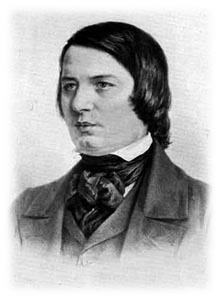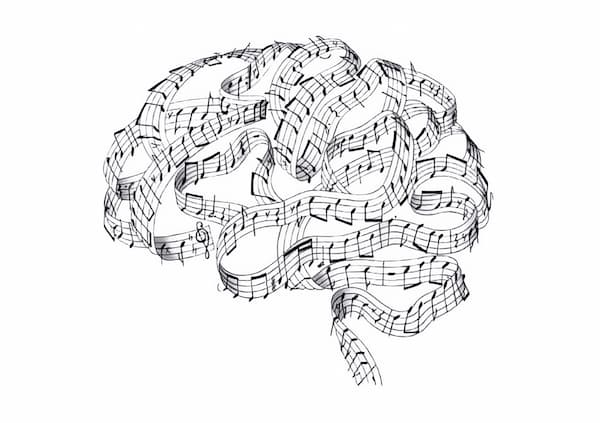 Robert Schumann (1810 – 1856) is widely regarded as cornerstone to Germany’s romantic era. Not only was he an accomplished composer, he also inaugurated and published for Die Neue Zeitschrift für Musik (the New Journal for Music), one of the most important musical publications of the nineteenth century.
Robert Schumann (1810 – 1856) is widely regarded as cornerstone to Germany’s romantic era. Not only was he an accomplished composer, he also inaugurated and published for Die Neue Zeitschrift für Musik (the New Journal for Music), one of the most important musical publications of the nineteenth century.
Robert Schumann: Symphony No. 4 in D minor, Op. 120 (revised version, 1851)
Yet amidst his musical and editorial successes, the most life-changing event was possibly his marriage to Clara Wieck (1819 – 1896). Wieck did not only stand out as a wife and mother, bearing him eight children and caring for him throughout his years of sickness, she was also a talented pianist herself. She encouraged Schumann to expand his repertoire beyond the piano to include symphonies, and Symphony No. 4 was written in commemoration of her birthday. She also contributed heavily to Schumann’s popularity by performing his works for many years after his death.
In 1843, the Leipzig Conservatory of Music hired Schumann as a piano professor. Sadly, his neurological problems inhibited his capacity for teaching and composing. Twelve years later, an attempted suicide left him confined to a private mental institute near Bonn, where he passed away two years later.
 It is widely rumoured that Schumann had contracted the sexually-transmitted disease syphilis during his lifetime. His youth was a ‘playful’ one, as reflected in several piano compositions that he named after different women. It was not until 1991 that disclosure of his diary entry confirmed that he was indeed diagnosed with syphilis in 1831.
It is widely rumoured that Schumann had contracted the sexually-transmitted disease syphilis during his lifetime. His youth was a ‘playful’ one, as reflected in several piano compositions that he named after different women. It was not until 1991 that disclosure of his diary entry confirmed that he was indeed diagnosed with syphilis in 1831.
Although an autopsy was carried out following Schumann’s death, the record had mysteriously gone missing. Thus, for years it was believed he died from tertiary syphilis affecting his brain. Yet, it continues to puzzle the medical world why his wife, who had bore him eight children, did not suffer from any symptoms of syphilis, and was even able to perform normally for many years thereafter.
The record of the autopsy was finally rediscovered in 1973. Richarz, the director of the hospital in which Schumann was admitted, carried out the autopsy. He wrote that Schumann’s brain weighed 1336 grams and showed no signs of shrinkage. Although the lower base of his brain revealed an unknown gelatinous tumor, there were neither signs of inflammation nor any signs of syphilis. The report had supported none of the hypotheses surrounding Schumann’s underlying illness in the literature.
For this reason, the medical view of Schumann’s death changed. It turned out that Schumann has been wronged for many years—syphilis was not the cause of his mental problems. However, he did suffer from manic depression which caused him to fluctuate dramatically between heightened excitement and severe depression. At times he was unable to write anything, and at other times he displayed outrageous productivity. For example, in the year he married Wieck he had produced one hundred and fifty piano pieces.
Kreisleriana, Op. 16
 Patients of manic depression often report feeling invincible during episodes of mania. Schumann’s high regard for his own musical hallucinations corresponded with this. It may further explain why schizophrenia was present amongst his children. Schumann’s bouts of mania and depression were also reflected in his letters and writings. He signed the name ‘Florestan’ in times of heightened emotions, but took the name ‘Eusebius’ when severely depressed. Critics say that his greatest work, ‘Kreisleriana’, actually resembles the two poles of his manic depression. The second, fourth and sixth movements are in B-flat major, while the third, fifth and eighth chapters are in G minor; the first three movements are melodically slow and reflective, while the last three are energetic and lively.
Patients of manic depression often report feeling invincible during episodes of mania. Schumann’s high regard for his own musical hallucinations corresponded with this. It may further explain why schizophrenia was present amongst his children. Schumann’s bouts of mania and depression were also reflected in his letters and writings. He signed the name ‘Florestan’ in times of heightened emotions, but took the name ‘Eusebius’ when severely depressed. Critics say that his greatest work, ‘Kreisleriana’, actually resembles the two poles of his manic depression. The second, fourth and sixth movements are in B-flat major, while the third, fifth and eighth chapters are in G minor; the first three movements are melodically slow and reflective, while the last three are energetic and lively.
Besides Schumann, other renowned composers who may also have suffered from manic depression include G.F. Handel, O Klemperer and Gioacchino Rossini. Before the age of thirty-seven, Rossini wrote 37 operas, yet his productivity declined dramatically in the next forty years when severe depression prevailed. Many people attribute his early years of heightened creativity to his manic depression.
Schumann also suffered from a condition in his right hand which numbed and stiffened his fingers. He started to complain of this problem from the age of 22 and was told that prolonged piano-playing would have affected his arms as well. As with his mental illness, people used to say it was the syphilis. However, just as rumours tainted his early death, syphilis had nothing to do with it. Recent medical analyses reveal that Dystonia, a neurological disorder which causes involuntary muscle contractions, was the real cause to blame.
References:
Garcia de Yebenes J. (1995). Did Robert Schumann Have Dystonia? Mov Disord. , 413-7.
Janisch W, Nauhaus G. (1986). [Autopsy report of the corpose of the composer Robert Schumann– publication and interpretation of a rediscovered document]. Zentralbl Allg Pathol. , 129-36.





“…she was also a talented pianist herself.” That is the understatement of the century. She was a superstar, and her husband was a nobody. He became famous through her efforts. She was already an international sensation as a child prodigy before they met, and eventually became the world’s most famous pianist next to Liszt.
Well, he became, and remains, famous because he was a composer of genius, unlike her.
God damn right! By the age of 16 years, she already had met personally Goethe, Lizst and Chopin, who all recognized the power and exceptionality of her talent. I don’t mean to undermine Schumann’s great talent (specially in composition), but Clara was a musical beast and if she didn’t had to financially support her whole family with her piano concerts, maybe she would have had more time to compose more and leave an even bigger mark in the history of classical music.
It’s about time people be made aware that Schumann had a brain tumor, not syphilis in the brain. His mother and sister also suffered from mental illness; could they have grown brain tumors as well? Are these unfortunate growths inherited, for example, like ovarian or breast cysts?
Music historians’ overwhelmingly believe Schumann died of neurosyphilis. He contracted it in 1831 most likely while a piano student in the Weick home. There was a servant girl and a female piano student in the home . He was attracted to both. He quite possibly had manic depression, also possible schizophrenia. He drank too much, and high blood pressure was also likely. It’s a wonder he could function at all, let alone compose some of the most beautiful music ever!
Schumann had contracted syphilis before his marriage. He wrote as much in his diary. It is therefore likely that by the time he married Clara Wieck his disease had progressed to the latent phase. In other words the disease was active within his body but he was not infectious. Syphilis was an incurable disease until penicillin was available so Schumann’s belief that he had been cured by the administration of arsenic was ill founded. He may have had manic depression but tertiary syphilis as a cause of his death cannot be ruled out.
A gumma in the brain is a gelatinous tumor.